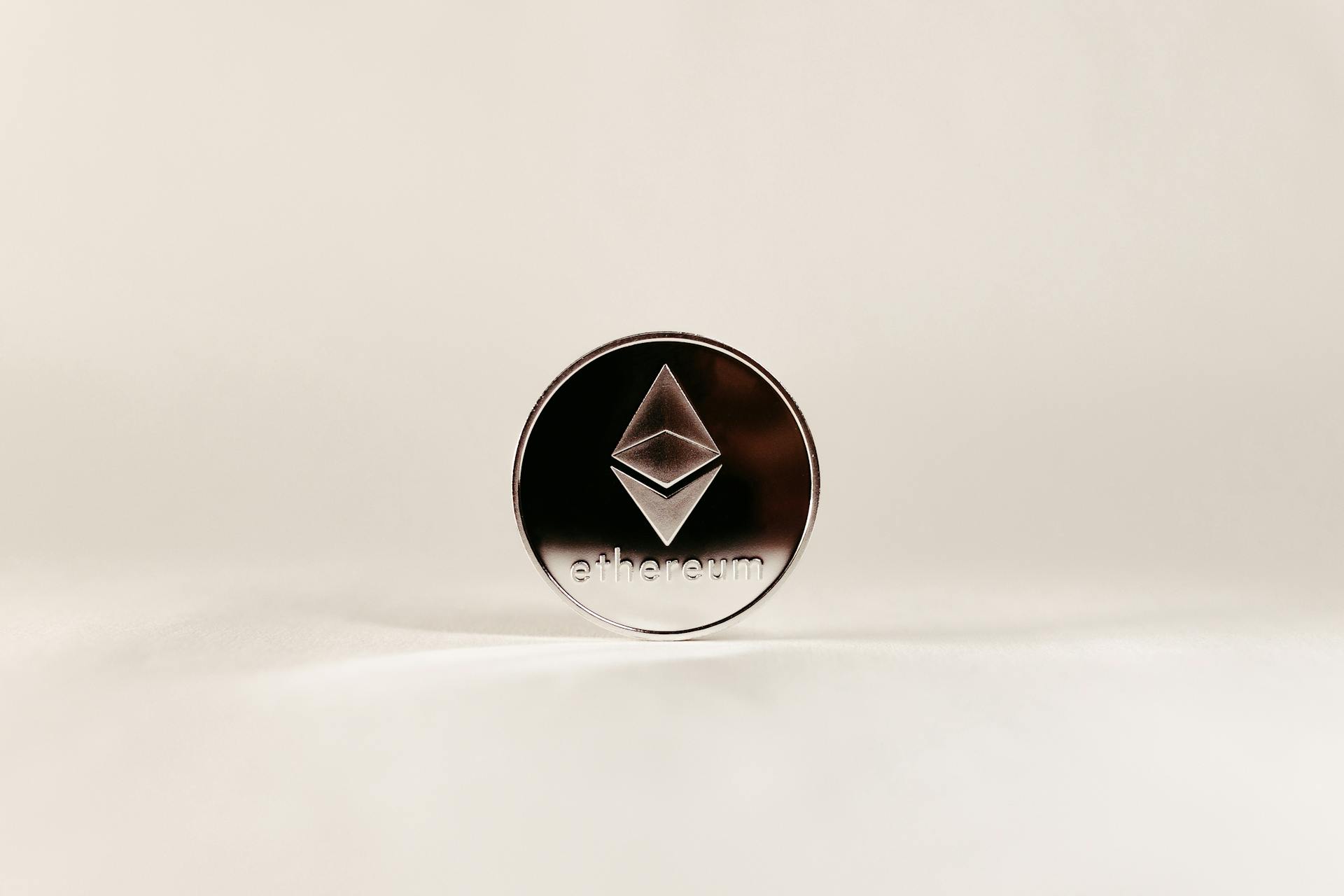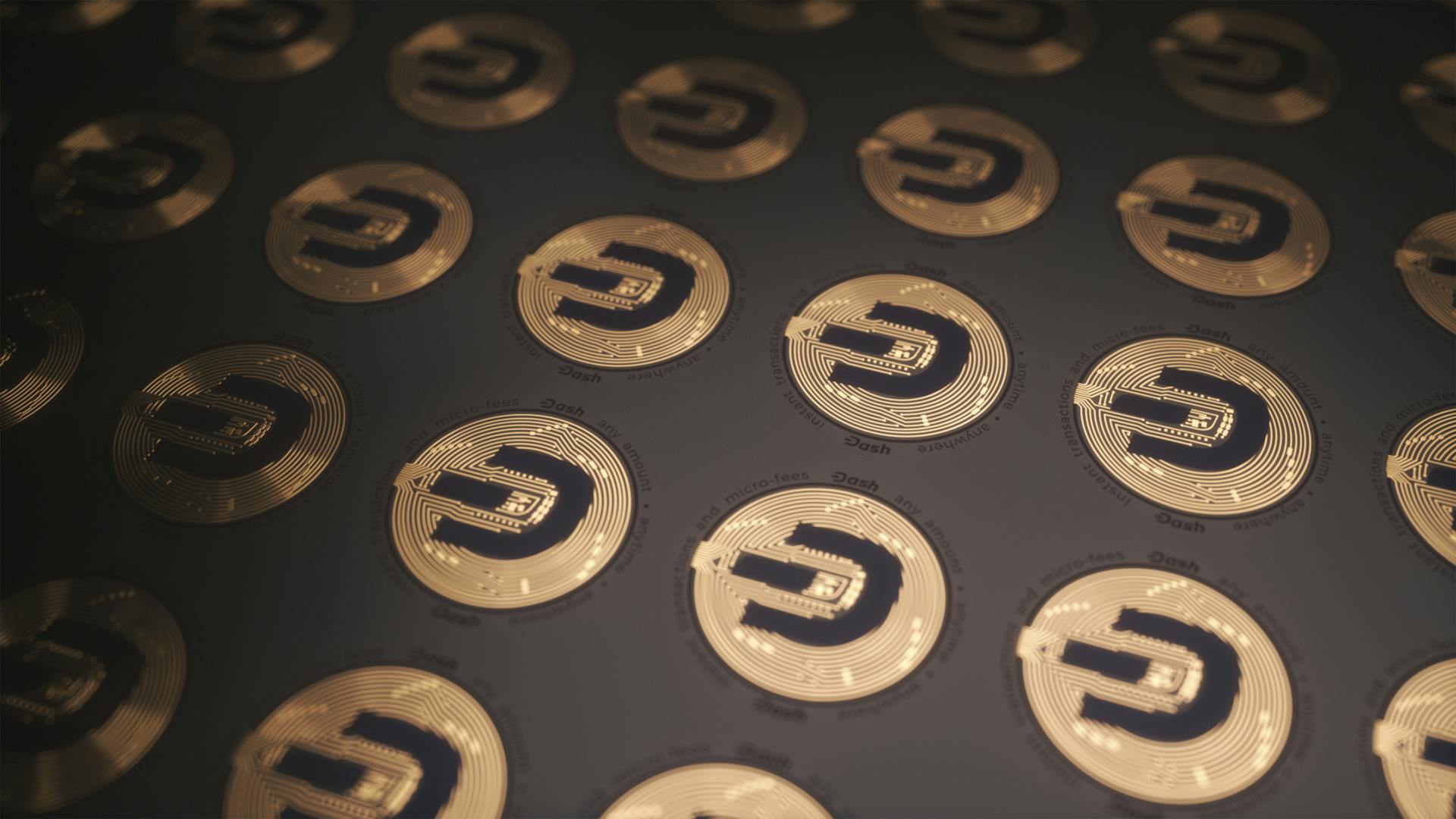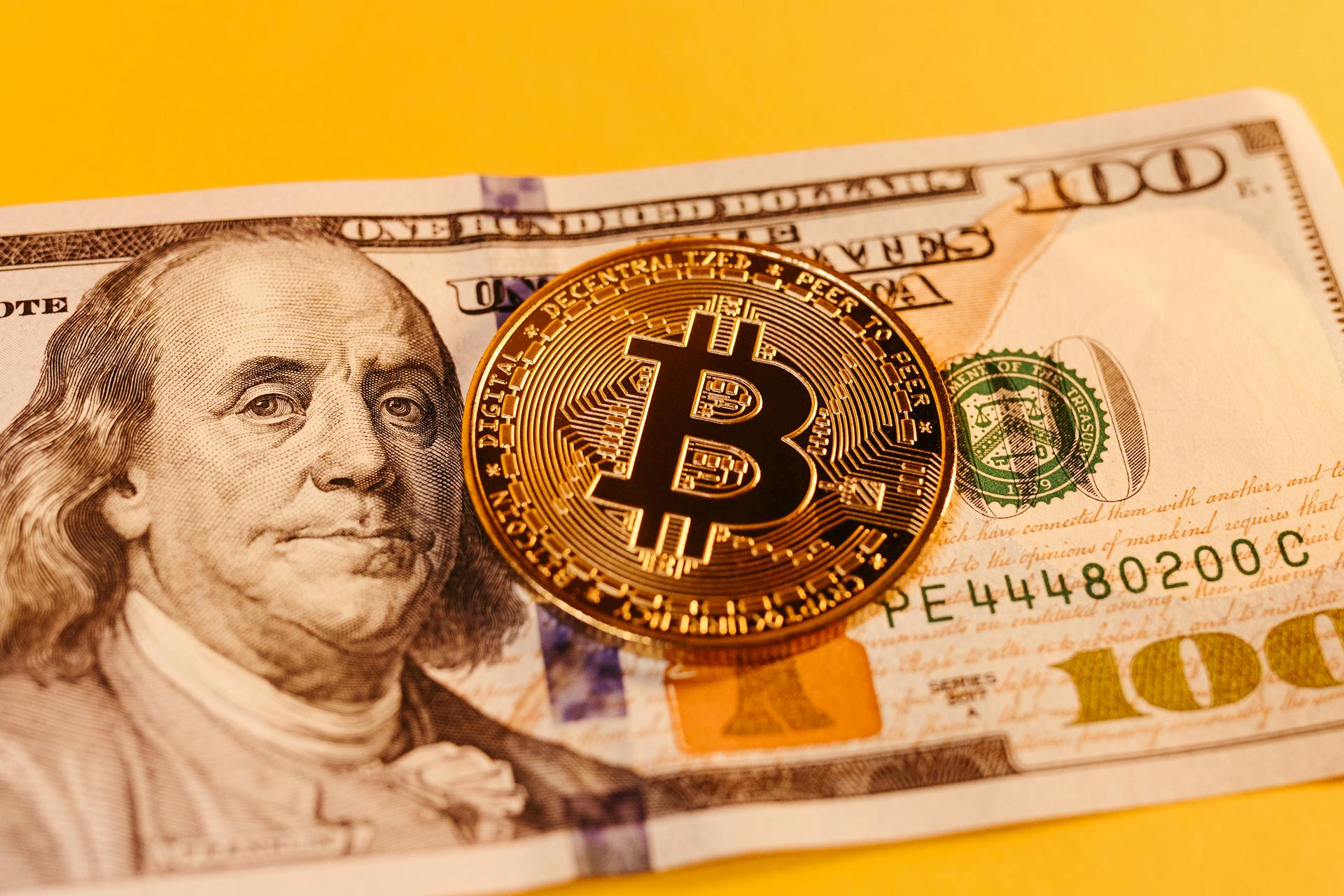
Decentralized finance platforms, or DeFi, are revolutionizing the way we think about money and finance. DeFi platforms allow users to lend, borrow, and trade cryptocurrencies without the need for intermediaries like banks.
These platforms are built on blockchain technology, which provides a secure and transparent way to record transactions. The first decentralized lending platform, MakerDAO, was launched in 2017 and used a stablecoin called DAI to reduce volatility.
DeFi platforms have grown rapidly in popularity, with the total value of assets locked in DeFi protocols reaching $25 billion by the end of 2020. This growth has attracted the attention of investors and users alike, who are drawn to the potential for high returns and greater financial freedom.
Broaden your view: Ibkr Trading Platforms
Key Characteristics
Decentralized finance platforms, or DeFi, are built around decentralized applications, or DApps, that perform financial functions on distributed ledgers called blockchains. These DApps are accessed through a browser extension or application, such as MetaMask, which allows users to directly interact with Ethereum through a digital wallet.
DApps can be linked to create complex financial services, like stablecoin lending, where users can lend assets like USD Coin or DAI to a liquidity pool in a borrow/lending protocol such as Aave Protocol. This protocol automatically adjusts interest rates based on demand for the asset.
Some DApps source external data, like asset prices, through blockchain oracles. Aave Protocol popularized "flash loans", which are uncollateralized loans taken out and paid back within a single blockchain transaction.
Here are some examples of DeFi services that use DApps:
- Stablecoin lending
- Decentralized exchanges (DEXs) like Uniswap, which trades tokens issued on Ethereum
- Peer-to-peer borrowing and lending
- Crypto exchange services
- Crypto wallet and storage solutions
These services are preprogrammed by developers and can execute transactions on specific blockchain networks, settle agreements between buyers and sellers, or move assets between platforms. One popular benefit for cryptocurrency investors is the ability to generate income through crypto staking, which allows owners to help support the coin's ecosystem and earn income by validating transactions.
Yield farming is a way to put crypto assets to work to earn passive income, where investors provide liquidity or loans to DApps in exchange for interest and fees. This can be done through various services, such as providing liquidity in a coin exchange, lending peer-to-peer, borrowing against holdings, or staking in a proof-of-stake coin like Ethereum.
A unique perspective: Uniswap Liquidity Pool
How It Works
Decentralized finance platforms, or DeFi, use blockchain technology to create a more direct and secure way of making transactions.
Blockchain is a digital ledger that's shared and updated by all participating computers, making it virtually tamper-proof.
Transactions on a blockchain are verified by select nodes participating in the network, and once a block is closed, its contents are permanently sealed and cannot be changed.
This means that any attempt to alter the contents of a block will alert all computers on the network, making it a very secure system.
DeFi uses this technology to create new infrastructure for delivering financial products and services, such as loans, interest on deposits, and payments.
Smart contracts, which are executable codes that can store cryptocurrencies and interact with the blockchain, are the building blocks of DeFi.
These contracts automatically execute transactions among participants, and when the contract's conditions are fulfilled, they self-execute their set of instructions.
For another approach, see: Defi Smart Contract
In DeFi, cryptocurrency becomes the de facto currency for transactions and records, and peer-to-peer transactions can include everything from payments to investments and lending.
Smart contracts replace financial institutions in transactions, giving individuals and businesses more control over their finances and eliminating the need for intermediaries.
A smart contract is a type of Ethereum account that can hold funds and send or refund them based on certain conditions, and once it's live, no one can alter it.
Contracts are also public, allowing anyone to inspect and audit them, which helps keep developers in check and prevents bad contracts from going unnoticed.
Consider reading: Defi Smart Contract Development
Key Benefits and Risks
Decentralized finance platforms, or DeFi, offer users more control over their money, with financial assets transferable in seconds or minutes and service fees largely abolished. This is because DeFi eliminates the need for third-party companies to assist with transactions.
One of the key benefits of DeFi is its potential for greater security, as security measures like on-chain data allow for verifying and recording transactions on the blockchain. This provides an added layer of protection for users.
Suggestion: Defi Liquidity Mining
DeFi also offers potentially lower costs, as users can avoid paying fees to banks and other financial institutions. This is especially beneficial for individuals who may not have access to traditional banking services.
However, DeFi is still a relatively new and untested technology, which means that there is no unified or comprehensive way to determine whether any part of a DeFi system is operating at optimal capacity or is free from scams. This lack of regulation and oversight creates a significant risk for users.
Some of the biggest risks associated with DeFi include outright scams, theft, and volatility. Scammers may promise unusually high yields to lure in unsuspecting investors, while theft can occur through exploits in the code of DeFi applications.
Here are some of the key risks associated with DeFi:
- Complexity: Participating in DeFi can be challenging for beginners due to the vast number of DeFi applications and investment opportunities.
- Outright scams: Scammers may promise unusually high yields to lure in unsuspecting investors.
- Theft: Crypto coins may be stolen via exploits, especially given the vulnerabilities of coding in some DeFi applications.
- Cost: Interacting with smart contracts requires gas fees, which can add up quickly.
- Volatility: Cryptocurrency values can fluctuate wildly, making it difficult to predict yields.
- Fluctuating yields: Yields can fall as more supply supports a given app.
- Dying projects: A given DeFi application may ultimately be left to die on the vine, as the core team developing it pursues other projects.
Traditional Finance vs Decentralized Finance
Traditional finance can be slow and cumbersome, with transactions taking days due to manual processes. Payments can also be blocked due to financial services restrictions.
In traditional finance, your money is held by companies, and you have to trust them not to mismanage it. You may also have to apply to use financial services, and the markets close when employees need breaks.
Decentralized finance, on the other hand, allows you to hold your own money and control where it goes. Transactions happen in minutes, and the markets are always open.
Here's a comparison of traditional finance and decentralized finance:
It Started with Bitcoin
Bitcoin was the first DeFi application, allowing people to own and control value and send it anywhere around the world.
It provided a way for a large number of people to agree on a ledger of accounts without the need for a trusted intermediary.
Bitcoin is open to anyone and its rules, like its scarcity and openness, are written into the technology.
No one has the authority to change its rules, unlike traditional finance where governments can print money that devalues your savings.
Bitcoin's openness also means that companies can't shut down markets, giving users more control over their finances.
Challenging Traditional Banking
Traditional banking has been around for centuries, but DeFi is challenging its very foundations. Banks and financial institutions can help you transfer funds, but the route isn't direct, often involving a chain of third-party service providers that slow down transactions and charge service fees.
DeFi promises innovation that's unachievable using traditional systems and technologies. It's not just about making incremental improvements, but about revolutionizing the way we exchange financial products.
Banks can't just co-opt DeFi technology and offer it without dealing with the regulatory burden. Integrating blockchain technology would require revision of many well-established processes while opening them up to additional risks.
Here are some key differences between DeFi and traditional finance:
DeFi's decentralized nature means that individuals and businesses can make peer-to-peer financial transactions without relying on third-party service providers. This could be a game-changer for those who struggle to access financial services or are frustrated with the slow pace of traditional banking.
Decentralized Finance Platforms
Decentralized finance platforms are revolutionizing the way we think about financial transactions. They offer a decentralized alternative to traditional financial systems, allowing for peer-to-peer transactions without the need for intermediaries.
Decentralized exchanges, or DEXs, are a type of cryptocurrency exchange that allow for direct peer-to-peer transactions to take place without the need for an intermediary. This reduces the risk of theft from hacking of exchanges.
DEXs use blockchain or distributed ledger technology to facilitate transactions, and some common methods of operation include the use of smart contracts or order book relaying. This allows for 24/7 trading, 365 days a year, and the technology guarantees there will always be someone to accept a trade.
Decentralized lending platforms, on the other hand, allow individuals to lend and borrow money without the need for credit checks or handing over private information. This is made possible by the use of collateral, such as NFTs, which are unique digital assets.
See what others are reading: Crowdlending Platforms
Some popular decentralized lending platforms include Aave, which allows users to earn interest on their crypto by lending it and see their funds grow in real time. The interest rates on these platforms are often much higher than what you'd get at a traditional bank.
Decentralized finance platforms also offer a range of other services, including stablecoins, which are cryptocurrencies pegged to the value of a traditional currency, and decentralized exchanges, which allow users to trade different tokens without giving up control of their assets.
Here are some of the key features of decentralized finance platforms:
Overall, decentralized finance platforms offer a range of benefits, including increased security, reduced fees, and greater access to financial services. They're still a relatively new and rapidly evolving field, but they have the potential to revolutionize the way we think about financial transactions.
Security and Regulation
Decentralized finance platforms are subject to increasing scrutiny from regulatory bodies. In October 2021, the Financial Action Task Force (FATF) included DeFi in its guidance for crypto service providers, aiming to regulate this type of asset.
Each country is expected to determine if individuals involved in DeFi can be considered a virtual asset provider and be subjected to the FATF's guidelines. This has significant implications for the DeFi industry, which has traditionally operated with minimal oversight.
The FATF's guidance highlights the need for DeFi platforms to prioritize security and regulation. By understanding the regulatory landscape, DeFi platforms can better serve their users and maintain a competitive edge in the market.
Errors and Hacking
Errors in DeFi coding can be costly, with blockchain transactions being irreversible, making it difficult to correct incorrect or fraudulent transactions.
Blockchain transactions are irreversible, which means that an incorrect or fraudulent DeFi transaction cannot be corrected easily.
Some DeFi protocols have been described as "Ponzi-like", suggesting a lack of transparency and potential for scams.
Investor Michael Novogratz has expressed concerns about the risks of DeFi, highlighting the potential for inexperienced investors to lose money.
Inexperienced investors are at particular risk of losing money due to the sophistication required to interact with DeFi platforms and the lack of any intermediary with customer support.
In 2021, half of cryptocurrency crime was related to DeFi, indicating a significant security risk in the space.
Theft from DeFi can come from either external hackers stealing from vulnerable projects or "rug pulls", where the developers and influencers promote a project and then take the money.
A unique perspective: Risk Financing
Regulation
The regulation of DeFi is a complex and evolving topic. In October 2021, the FATF included DeFi in the guidance for crypto service providers.
The FATF's aim is to regulate this type of asset, but each individual country will determine if individuals involved in DeFi can be considered a virtual asset provider and be subjected to the FATF's guidelines.
Regulators are taking a closer look at DeFi to ensure it's operating within the bounds of the law. This includes determining if DeFi platforms are subject to anti-money laundering and know-your-customer regulations.
The FATF's guidance is a step towards standardizing regulations across countries. This will help to build trust in the DeFi space and provide clarity for individuals and businesses operating within it.
The FATF's focus on DeFi is a recognition of its growing importance in the financial world. As DeFi continues to evolve, we can expect to see more regulatory efforts aimed at ensuring its stability and security.
To stay up to date with the latest regulatory developments, be sure to follow reputable sources in the crypto and DeFi space.
New Technologies and Applications
Decentralized finance platforms are becoming increasingly popular, and it's exciting to see new technologies and applications emerging.
Set Protocol offers automated asset management of portfolios, allowing for more efficient and secure investments. Augur provides decentralized prediction markets, enabling users to bet on future events.
Lightning Network facilitates retail payments in Bitcoin, making it faster and cheaper to send and receive cryptocurrency. Chainlink powers the Ampleforth protocol, utilizing commodity-based money for more stable transactions.
These innovative solutions are just the beginning, as new tools and features are being added to the smart contract stack to address current limitations in DeFi development.
Web3
Web3 is the next step in the evolution of the Internet, and it's built on blockchain technology, which allows for secure and transparent transactions.
This is the foundation on which Ethereum is based, enabling users to send money around the globe quickly and easily, just like sending an email.
Ethereum's programmable money feature allows users to program logic into payments, giving them control and security, similar to Bitcoin, but with the added ability to do things like lending and borrowing, scheduling payments, and investing in index funds.
The DeFi ecosystem on Ethereum is flourishing, using ETH as the dominant form of reserve collateral, making it a permissionless store of value that can be used to create additional credit.
This is a major departure from traditional banking, where collateralization rates are often strict, but with Ethereum's decentralized system, the possibilities for financial innovation are vast.
Zero-Knowledge Proofs (ZKP)
Zero-Knowledge Proofs (ZKP) are a game-changer for online transactions, allowing users to prove a statement is true without revealing any underlying information.
This technology ensures that sensitive data remains private, even when performing complex computations.
Zero-Knowledge Proofs provide a way to verify the validity of a statement without exposing any confidential information.
Imagine being able to prove you're over 18 without sharing your birthdate - that's the power of ZKP.
Other Applications and Use Cases
Decentralized finance platforms offer a wide range of applications beyond lending and borrowing.
Set Protocol allows for automated asset management of portfolios, making it easier to manage investments.
Augur enables decentralized prediction markets, where users can bet on the outcome of events.
The Lightning Network facilitates retail payments in Bitcoin, enabling fast and low-cost transactions.
ICOs (Initial Coin Offerings) are used for token-based crowdfunding, allowing projects to raise funds from a large number of people.
STOs (Security Token Offerings) are used for equity-based crowdfunding, giving investors a share of ownership in a project.
Stablecoins are a type of cryptocurrency designed to maintain a stable value, often pegged to a fiat currency.
Chainlink powers the Ampleforth protocol, which uses commodity-based money to maintain a stable value.
Staking is used in underlying consensus protocols such as POS (Proof of Stake) and DPOS (Delegated Proof of Stake), allowing users to participate in the validation of transactions.
DAOs (Decentralized Autonomous Organizations) use staking in the form of VC funds, insurance funds, and protocol governance.
Frequently Asked Questions
What is the best platform for DeFi?
There is no single "best" platform for DeFi, as each of the top platforms (MakerDAO, Compound, SushiSwap, Curve Finance, Balancer, Yearn Finance, PancakeSwap, and Synthetix) excels in different areas, such as lending, yield farming, or decentralized exchanges. To find the best platform for your specific needs, explore each option to determine which one aligns with your goals and risk tolerance.
Featured Images: pexels.com


